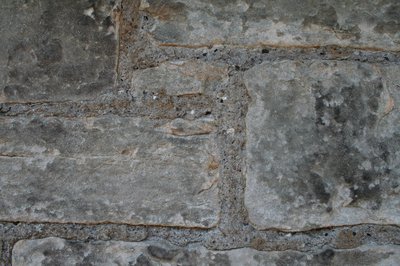The Scottish Lime Centre Trust are specialists in the analysis of historic and modern mortars, ranging from clay/earth mortars, lime bound mortars to early patented cement mortars and everything else in between.
We assess all samples of mortar as they are received and using our expert knowledge, and in consultation with our clients, we agree on the most appropriate method or methods of analysis to undertake based on the project requirements. You are welcome to contact us before sending samples for advice or to receive a competitive quote.
Mortar analysis by acid digestion (10 – 15 working days for the report)
This is our standard analysis procedure which we employ for the analysis of lime mortar, render and plaster. This allows the identification of the original lime binder composition (dry hydrate, quicklime, putty), its mode of use (cold or a hot-mix lime mortar), and its original hydraulicity (non-hydraulic, feebly, moderately, eminently), as well identifying and matching the original aggregate used in its production.
X-Ray Diffraction (XRD) (lead time of 10 – 15 workings days: analysed out-of-house so cannot always control this lead-time).
In similarity to the standard mortar analysis procedure, the sample is initially dried for its original moisture content, tested for its water absorption, degree if carbonation and visually analysed.
BS4551 for cementitious samples (lead time of 10 – 15 workings days: analysed out-of-house so cannot always control this lead-time).
This analysis is also undertaken out-of-house and follows the same initial in-house procedure of moisture content, water absorption, carbonation and visual observation analysis. A single sub-sample of representative sample is then packaged and sent (usually dropped off personally) to the external lab for analysis.
Petrographic Analysis (lead time of 4 - 6 weeks: analysed out-of-house so cannot always control this lead-time).
We can also undertake petrographic thin section analysis of mortar for matching and various other applications, respectively.
Sampling
Allow for this in your programme as some techniques require out-of-house lab assistance and cannot be expedited. Work will only commence once the Sample Information Sheet and Client Detail Form have been received fully completed, with an adequate size sample. The information given for each sample helps us develop our Historic Mortars Database which will find trends in historic mortars. Please note that a mortar analysis is not a specification for replacement mortars.
Your sample must be:
- at least 50g in weight but preferably over 100g;
- intact as a single or multiple pieces;
- placed into a sealed and well labelled bag;
- well packaged to ensure it arrives in the same condition as it was sent.
Mortar Sample Information Sheet (99.7 KB) - This should be completed and sent to us either with your sample or scanned and sent to us by email prior to sending the sample. (1 sample sheet per sample)
This form needs to be completed and returned before we can start any chargeable work. Ensure that you check and sign, as work will be delayed until we receive a signed form.
Methods of Mortar Analysis Available
There are many different options when it comes to mortar analysis as you can see from the table below, but don’t worry! We will talk you through the best forms of analysis for your sample and then allow you to make the decision on how to proceed when you have all of the information you need.
| Method of analysis | Wet Chemistry Analysis (SLCT ‘Mortar Analysis by Acid Digestion’) | Petrographic Analysis by Optical Microscopy | Analysis by British Standard 4551 | X-Ray Diffraction (XRD) | X-Ray Fluorescence (XRF) | Physical Testing | |
|---|---|---|---|---|---|---|---|
| Suitability for binder type | Lime | * | * | * | * | * | |
| Cement | * | * | * | * | * | ||
| Clay / earth | * | * | * | * | |||
| Results available | Visual description | * | * | * | * | * | * |
| Original mix proportions | * | * | * | ||||
| Visual identification of binder type | * | * | * | * | * | ||
| Mineralogical identification of binder type | * | ||||||
| Chemical identification of binder type | * | ||||||
| Aggregate characterisation | * | * | * | ||||
| Aggregate grading | * | ||||||
| Aggregate match1 | * | ||||||
| Mortar mix to match existing2 | * | ||||||
| Physical characteristics | * | ||||||
- This service is currently available for all mortars sampled in Scotland and is being expanded to cover mortar samples from the rest of the U.K.- please contact us if you would like to find out if the service is available for the location of your site.
- This is not a specification because it does not take into account building use, mortar function, location, exposure, etc.
Our fees are available upon request.
Additionally, we CANNOT dispatch reports before we receive a fully completed and signed client detail form. We also require the sample information sheet to be delivered with the sample: this allows a significantly more efficient analysis procedure. We cannot comment on certain aspects of the sample without being provided important information on the sample (such as the age and use of the mortar, where it was taken from in the building/structure, what type of structure and its location). Pictures of the sample in-situ and/or of the building from which the sample was taken from are also extremely important and are sometimes required before we can comment fully on the analysed sample. Additionally, our mortar analysis (as a stand-alone service) only provides a starting point for replacement specification. WE WILL NOT specify replacement mortars without first undertaking a site visit and building survey.
